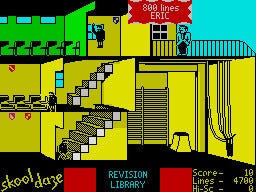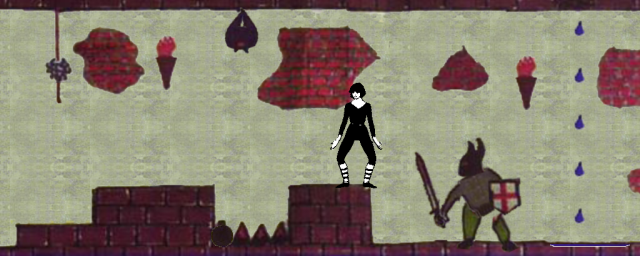Trending
Opinion: How will Project 2025 impact game developers?
The Heritage Foundation's manifesto for the possible next administration could do great harm to many, including large portions of the game development community.
When I set out to make a single-level game based on a picture from an old gaming magazine, I soon found out that there are 4 principles I have to follow to make it more exciting.

“Возвращение в замок злого колдуна” (Return to Evil Warlock’s Castle, or simply BB33K) is a game based on an idea that was sent, along with a picture of a level, in 1995 to a Russian gaming magazine called Great Dragon. It was a very evocative picture, and I decided to bring it to life.

I could go about it two ways: make a multi-level game, reworking the general art style into my own vision (e. g. pixel art), following the author’s clues to make more levels; or just dump this picture into the editor and make the game out of it.
I chose the second way. I was frankly tired of pixel art as a signature indie visual style. There IS good pixel art out there, but as you know, it's few a far between – and I certainly wouldn't create the best examples of it. Those rough, marker-coloured drawings were fresh, despite being more that 20 years old. I looked at this picture and said: “This is it. This is my whole game. Now how do I make people not finish it in 5 minutes, but still be interested enough to play it repeatedly?”
The answer, it turned out, was manifold.
First, the game had to be non-violent. At first it had nothing to do with the game itself, but with the fact that my son was often looking over my shoulder, and I didn’t really want to give him an idea that game development should necessarily include creating scenes of carnage. So, the hero was stripped of his weapon (and also became a heroine after I found a centerfold from and old Soviet aerobics record sleeve).

The decision proved fruitful: now the game could become something less trivial and monotonous than “kill this monster, now kill that monster, now kill that one…” The monsters would stay, but you had to deal with them some other way.
So here I come to my second point: I wanted everything to work not quite how you would expect. That would mean that some monsters wouldn’t outright kill you. There are still ones that do – and you may say that it kinda negates my point about non-violence, but at least it’s never a gory death. Weird, maybe. Also, the violence never comes from the heroine. Again, the monsters that don’t kill you can have an unusual effect on you – and some effects are not altogether bad. Also, the spikes are not instant death, and the torches aren’t a source of coins hearts like in Castlevania, or just wall decorations like in other games.
Because my third point was that everything has to work somehow. The level is too small to have something as pure visual candy. The portraits aren’t just pictures on the wall. The torches aren’t just animated sprites. You get grabbed, and you get burned. The coffin on the lowest floor looks non-interactive, but its meaning becomes clearer if you get to the second floor. And if some things look like bonuses in the original picture, but can’t be collected in the game – you’d better pay attention to them anyway.
The last point: time is crucial. When I made the decision that the game ends when the song ends (unless you win), it all came together. The monsters and obstacles that don’t kill you still delay you, change or obscure your movement. And the final boss won’t destroy you, but will cut your time short. There are also things in the game that are time-dependent: the puddles from the falling water grow and become more dangerous – and not only to you. Again, if your game world is tiny, one way you can make it more diverse is to make it change with time. One good old example of this is the old ZX Spectrum series Skool Daze/Back To Skool, where the rules of the game worked differently during lessons and between them – you had to be in your class when the bell rings, but had more freedom at breaks.

In BB33K, the schedule is not that involved, but you still are in a race against time where you learn the rules as you go.

So what I got at the end was a game that have to be finished in 7 minutes, but the one that you probably won’t finish in your first 7 minutes. Does it have enough staying power to make you play it again? Please answer in comments!
“Возвращение в замок злого колдуна” is out now, for free, on itch.io and IndieDB.
Read more about:
BlogsYou May Also Like